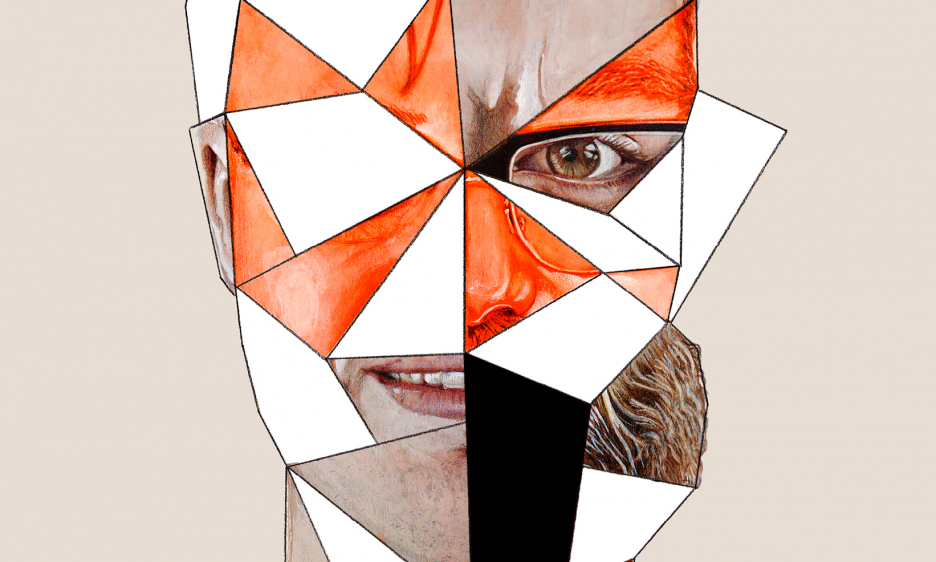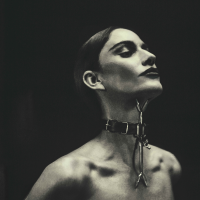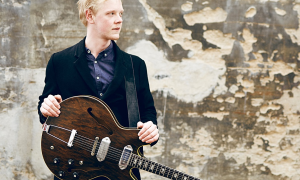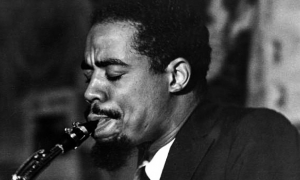Home » Jazz Articles » Hi-Res Jazz » TRPTK: Breaking Genre Walls
TRPTK: Breaking Genre Walls

TRPTK's albums, recorded with state-of-the-art audiophile technology, erase the boundaries of musical genres, and pursue a commonality of purpose that overrides differences in cultural and national backgrounds.
Æon Trio: Elegy
 Elegy, performed by the jazz ensemble Æon Trio of Japanese pianist-composer Atzko Kohashi, Dutch bassist Frans van der Hoeven and Russian-born cellist Maya Fridman, draws on the diverse streams of the Netherlands musical pool. The album, structured in a chamber-jazz framework, consists of reinterpreted standards, group improvisations, and original compositions by pianist Atzko Kohashi. The duo of Kohashi and van der Hoeven have performed together for several years. They appear on the albums Lujon, Waltz for Debby and Amstel Moments, and that partnership is the solid structure into which the adventurous classical cellist Maya Fridman opens new doorways.
Elegy, performed by the jazz ensemble Æon Trio of Japanese pianist-composer Atzko Kohashi, Dutch bassist Frans van der Hoeven and Russian-born cellist Maya Fridman, draws on the diverse streams of the Netherlands musical pool. The album, structured in a chamber-jazz framework, consists of reinterpreted standards, group improvisations, and original compositions by pianist Atzko Kohashi. The duo of Kohashi and van der Hoeven have performed together for several years. They appear on the albums Lujon, Waltz for Debby and Amstel Moments, and that partnership is the solid structure into which the adventurous classical cellist Maya Fridman opens new doorways. The term "chamber jazz" is often used to describe music that isn't actually jazz, but would be better characterized as new creative music. The music of Æon Trio is both jazz and new creative music, not one or the other, interspersing standards with group improvisation. The set has an arch-like structure, or perhaps it could better be analogized as a journey, as the song titles suggest: opening with Carla Bley's "Útviklingssang" followed by the Kohashi original "Tabidachi (Departure)"; closing with the Denny Zeitlin standard "Quiet Now" preceded by Kohashi's "Ieji (Returning)"; and anchored at the center by an inventive two-part arrangement of Ornette Coleman's "Lonely Woman."
"Tabidachi (Departure)," by pianist Kohashi, begins with a head melody by the ensemble that flows organically into a piano and bass duet of some delicacy and restraint. As Maya Fridman rejoins, she plays pizzicato, mirroring the sound of the bass. In "Blues for Maya," a theme based on a whole tone scale, Fridman emulates the sound of the koto, a delicate effect that she repeats in the opening of "Ieiji."
Ripples of Japanese motifs surface in the group's interpretation of "Lonely Woman." Following a slow-developing group interplay, Coleman's familiar theme is introduced towards the end of the section labeled Act I. In the Act II section, Fridman bows close to the cello's bridge to generate upper harmonics that brush a wide palette of tone color and emotional shading.
In recent years, the cello has assumed a prominent role in jazz/new-music ensembles. The work of Anja Lechner and Vincent Courtois is well documented by the ECM label. Cellist Jörg Brinkman brings a distinctive sound to the Eric Vloeimans "Oliver's Cinema" trio. In North America, Hank Roberts, Tomeka Reid and Peggy Lee, among others, are essential contributors to numerous projects. The engagement of younger cellists in contemporary Dutch jazz/new-music can be traced, in part, to the work of cellist Ernst Reijseger, who is cited as an artistic influence by the generation of musicians who followed him.
Cellist Maya Fridman attended master classes with Reijseger, and her involvement in cross-cultural musical projects demonstrates a commitment to intercultural artistic communication, and to bringing her instrumental voice to an audience outside the classical concert hall. In addition to her appearance in the Æon Trio and the remarkable performances of twentieth-century and new classical music on TRPTK, The Fiery Angel, The Invisible Link and Red Velvet, Fridman collaborates on The Scent of Persia, a set of Persian themes and improvisations, with Persian santoor virtuoso Arezoo Rezvani and percussionist Farid Sheek.
The interposing of a classically-trained cellist into a well-established jazz piano and bass duo provokes a three-way conversation not only of musical personalities, as in all jazz performance, but of musical idioms. Throughout the album, Maya Fridman's improvisations blend motifs from twentieth-century classical tradition into a seamless jazz tapestry woven by pianist Kohashi and bassist van der Hoeven. It might sound artificial in words, but as realized in these recorded performances, the divergent musical vocabularies operate inventively, and achieve a commonality of purpose.
Of Maya Fridman, pianist Kohashi writes:
She is so free in her performance; she seems to liberate herself from any constraints. Despite the many differences between us—nationality, culture and background—we found a common voice in our music.
Atzko Kohashi, who resides in the Netherlands, deserves to be better known to lovers of fine music everywhere. That so much of her career has been based in Japan and the Netherlands, and her earlier recordings not widely available, illustrates the challenges and barriers that a record label like TRPTK can help to overcome.
Kohashi studied in the United States with renowned pianist Steve Kuhn, following years of conservatory studies and studio work in her home country of Japan. Elegy is a showcase for her distinctive sound and compositional style. Kohashi doesn't remind me of any other pianists I've heard. She brings a meditative quality, a sense deep listening and emotional responsiveness, to the piano itself and to the other musicians in the trio.
She has a worthy interlocutor in bassist Frans van der Hoeven. Van der Hoeven plays the introduction and is the featured soloist on "Gary's Waltz." His deep bass timbre (rendered nearly three-dimensional by engineer Brendon Heinst), effortless technique and grasp of the unfolding conversation, strengthen the ensemble sound and maintain a sense of forward movement so that even the slowest passages don't feel static or overly languid. Bowing long sustained notes under Fridman and Kohashi's melodic lines, he keeps the ensemble firmly rooted.
It is no exaggeration to state that Elegy is one of the best-sounding hi-res recordings of jazz or contemporary music in my collection. I can compare TRPTK records favorably to the exemplary work of engineer Bert van der Wolf for the Challenge and Turtle labels. Any attempt to describe in words the clarity, transparency and warmth of TRPTK's house sound must fall short; visit the label's website and sample the musical banquet.
Personnel: Atzko Kohashi, piano; Maya Fridman, cello; Frans van der Hoeven, double bass
Rafael Fraga: Trova Caminhada

TRPTK records a broad spectrum of musical styles, reflecting the presence in the Netherlands of musicians from other countries who are drawn to the Netherlands' rich cultural landscape.
Guitarist-composer-singer Rafael Fraga was born in Lisbon, and the plaintive sound of Portuguese music is embedded in his DNA. Following studies in classical composition, degrees at the Escola Superior de Música de Lisboa and the Conservatorium van Amsterdam, he established a performing career in the Netherlands.
The Rafael Fraga Quartet recorded Trova Caminhada at MCO Studio 2 in Hilversum, the Netherlands, under the supervision of engineer Brendon Heinst. The album's blend of Portuguese folk, bossa nova and jazz elements evoke the work of Brazilian singer-guitarist Milton Nascimento; listening to Fraga's wordless vocal and Aki Spadaro's sympathetic piano accompaniment towards the end of "Está na Hora de Voltar," one can detect echoes of Nascimento's unmistakable falsetto, yet the effect is more of inspiration than imitation. Fraga's Portuguese guitar, built by luthier António Martins, produces tone colors in the bright end of the sound spectrum. He plays skillfully and without the kind of self-indulgent technical flourishes that would detract from the ensemble presentation.
The lyrics to Trova Caminhada are published in the accompanying booklet, though only in the original Portuguese. The imperfect tool of Google Translate cannot do justice to Fraga's writing, but the translations suggest that he is looking unflinchingly at the silences and wounds which inevitably occur at the most intimate levels of relationships. Even without knowing the exact meaning of the words, you can detect the weariness and the hint of hopefulness in Fraga's voice. This is late-night music of accomplished artistry.
The musicians in the Rafael Fraga Quartet add their respective national voices and musical pedigrees into the mix. Pianist Aki Spadaro, originally from Palermo, Sicily, received a degree in Jazz Piano at the Conservatorium van Amsterdam. He regularly performs, composes for films, and teaches in the Netherlands. Australian-born percussionist Efraim Schulz-Wackerbarth is another beneficiary of the jazz pedagogy in Dutch conservatories. His master's degree research on the music of the great drum innovator Tony Williams connects him to the progressive stream of American jazz. Anchored by bassist Marko Bonarius, the ensemble convey a distinctly jazz style that complements Rafael Fraga's neo-traditional songwriting. There is a seamless, seductive quality to this recording, enhanced by Brendon Heinst's expert engineering, that draws the listener in, for a closer musical—and deeper emotional—encounter.
Personnel: Rafael Fraga, vocals, guitar, Portuguese guitar; Aki Spadaro, piano, keys; Efraim Schulz-Wackerbarth, drums and percussion; Marko Bonarius, double bass; Aili Deiwiks, violin; Maya Fridman, cello
Martin van Hees: Remgewogen

Jazz has been in dialogue with other musical dialects throughout its roughly 100-year history, starting with its origins in the polyglot city of New Orleans, at the time, home to African-Americans, Cubans, Central and South Americans, French-and Italian-Americans. Over the decades, as the music spread geographically and evolved technically, jazz composition and improvisation increasingly drew on the harmonic material of then-contemporary classical music.
At the beginning of the 1960s, the revolutionary performances of pianist Cecil Taylor broke down the false dichotomy between jazz (low, popular) vs. classical (high, art) music. Taylor threw the whole question open to listeners, critics and his fellow musicians, and if relatively few American jazz players could follow where Taylor led, others opened their ears and turned their pens to the spectrum of musical styles and traditions from Europe to Africa, to Latin America and Asia. During a concert/master class given in the last year of his long life, Randy Weston (who lectured about the line of musical development beginning in Africa and extending through Moorish Spain into Europe) was asked by an audience member if there were any classical pianists who had influenced him. Weston answered: no; but that during the time he was learning by example from his mentor Thelonious Monk, he was also listening to Bach, to Debussy and Alban Berg, especially the Violin Concerto. He emphasized the point: 'all of us' listened to and were inspired by that music.
In many of the works by Dutch composers that guitarist Martin van Hees selected for his TRPTK recital recording Remgewogen, jazz-attuned listeners will recognize chords, melodic intervals and dynamic shadings that are part of the vocabulary of contemporary jazz and new improvisational music. In the opening sections of composer Roderik de Man's "Dulcamara," I heard passages that reminded me, almost involuntarily, of jazz ranging across five decades from Wayne Shorter's "Nefertiti" to "Imprint Double" from Sylvie Courvoisier's brilliant album D'Agala.
In the accompanying booklet for Remgewogen Van Hees describes how the album grew out of encounters with musicians of his own age cohort, Jan-Peter de Graaff and Christiaan Richter , and conversations with an earlier generation, including the well-known composer Louis Andriessen. Preparing the music for the album, van Hees took the opportunity
...to interview the composers personally, and additionally ask them intriguing questions; related to the contemporary music scene, the different notations used, and their intentions and thoughts behind their works.
In a sense, the recording is more than a recital; it is a presentation of the soloist's process, his efforts to broaden his own, and the listener's, musical experience.
The sudden silences, half-whispered pianissimo passages, and wide-leap intervals in Louis Andriessen's "Triplum" are drawn into a coherent presentation through van Hees' masterful technique and sensitivity to the composer's intentions. "Variations on a Quote by Debussy," a new work by Aart Strootman, a composer of the generation succeeding Andriessen, draws on the inspiration of early-twentieth century French modernism without resorting to pastiche or cliché. It's refreshing to hear a new work that is so approachable, an entryway to the album as a whole.
The two pieces on the album written by guitarist van Hees display the performer's skill at conveying those characteristics that are unique to the instrument, the tangible pull of fingers at the strings, the emotive warmth of the wood. "Ikariotikoyunbabarrange" builds variations on a minor key hymn-like theme towards a dramatic climax. It would be a natural encore for live performances. The meditative "Orewoet" shows a more introspective side of this talented young composer.
Jan-Peter de Graaff's "All that Changes" and Christiaan Richter's "Remgewogen," with their bold chromaticism, restless changes of mood and dramatic percussive effects, bring the album not so much to a close, as to an open question: Where does music come from, and where is it going?
The recording, made in the Lutheran Church, Haarlem (see the accompanying video), is of exemplary sound quality. Modern microphones and high resolution recording technology are the guitarist's best friend—and most intimidating adversary; every nuance of the performance is captured with vividness and detail.
Personnel: Martin van Hees; guitar.
QOPE (pronounced "cope") Nocturnal

During the session, I put up a very strict anti-ego policy. There's already way too many recording engineers and producers that make the whole session about themselves. I personally think it's much more important to be open to the artist not just as artists, but also as people. Brendon Heinst, in correspondence with the reviewer
Nocturnal is a set of concise, minimalist solo piano improvisations notable for clarity and inventiveness. Pianist-composer Bart Koop makes a virtue of simplicity in these eight spontaneous compositions. QOPE's pieces remind me of taking a night-time walk through a familiar neighborhood and noticing small details along the way that you'd never seen before. On first listening to Nocturnal, you might not notice the intentionality and careful preparation behind the gradually-shifting variations on basic harmonic materials, but with repeated exposure you begin to hear the underlying sophistication under the minimalist surface.
Approaching any new work by an unfamiliar composer, I always reach for the liner notes. But in lieu of explanatory commentary, Bart Koop weaves the titles of the eight pieces into a prose poem. "As the dusk falls.... if you could shut down all the streetlights.... return to yourself..." A willingness to let these phrases carry whatever personal meaning they might have offers a key to interpreting Koop's method.
A quote from his bio: "Bart takes his inspiration from the likes of Max Richter, Jóhann Jóhannsson..." led me to the music of Jóhann Jóhannsson, a contemporary Icelandic composer-performer known for his film soundtracks and ambient-minimalist works. Jóhannsson, who died in 2018 at the premature age of 48, drew from the contemplative stream of late-20th century Northern European music, as exemplified in the work of Arvo Pärt. That Jóhannsson could achieve popular success as well as critical acclaim points to the growing impact of new instrumental music that can be understood by non-specialist audiences.
The supportive environment that Brendon Heinst and Maya Fridman offer TRPTK artists is evidenced by the successful recording of Nocturnal live in the studio. The piano sound is well-balanced with generous room ambience, and the music is presented without editing or superfluous enhancement.
The music that Bart Koop shares on this recording, like that of the musicians who inspire him, can be appreciated as a vehicle for quieting the external distractions of the world and the internal obstacles of the mind, and though the performances are rooted in basic harmony, the flow of musical events, like the unfolding of life, is never that simple.
Personnel: Bart Koop; piano.
Coda: Building a Scene in High Resolution
Jazz scenes used to coalesce in 'magnet' cities: New York, Detroit, Philadelphia, Los Angeles and Chicago; Paris, Copenhagen, Rome, London and Tokyo; places that offered reasonable rent, sufficient work to support musicians and their families, an audience to support the performance spaces, and record companies to promote the artists through LP sales and radio play. But popular tastes changed, audiences "aged out" and moved to the suburbs, affordable rents grew scarce, and the record industry giants abandoned jazz in pursuit of the most profitable popular music styles.
In the past decade, the Internet, high-speed online access and social media, together with cultural institutions such as jazz foundations, music conservatories and fine arts organizations, have engendered jazz/new music "virtual scenes" that can be accessed by anyone with a fast enough connection. What may be lacking in virtual scenes are unexpected encounters with new ideas, the sense of immediacy, the feeling of being present in the moment of improvisation and innovation.
What TRPTK provides is both a local space for artists based in the Netherlands, and a virtual space in the form of the label's website and blog, for listeners at a distance. The cultural capital of any small jazz or new music label is the quality of its artists' production, and the confidence of label customers that the selection of new original music by unfamiliar artists will be curated with a consistent and recognizable aesthetic. The four albums reviewed in this column represent only a portion of TRPTK's output, and it is a hopeful sign that their catalog has grown steadily.
TRPTK's recordings are available in a range of resolutions on the label's website, and distributed in standard resolution on CD and download formats by this site's sponsors.
Original recordings in multichannel DXD. Downloads in stereo and MCH in DXD, DSD 64, 128 and 256, PCM 24/192, 24/96 and 24/44.1, CD and USB drive.
Albums in this review were downloaded in stereo 24/192.
Tags
PREVIOUS / NEXT
Support All About Jazz
 All About Jazz has been a pillar of jazz since 1995, championing it as an art form and, more importantly, supporting the musicians who make it. Our enduring commitment has made "AAJ" one of the most culturally important websites of its kind, read by hundreds of thousands of fans, musicians and industry figures every month.
All About Jazz has been a pillar of jazz since 1995, championing it as an art form and, more importantly, supporting the musicians who make it. Our enduring commitment has made "AAJ" one of the most culturally important websites of its kind, read by hundreds of thousands of fans, musicians and industry figures every month.


























